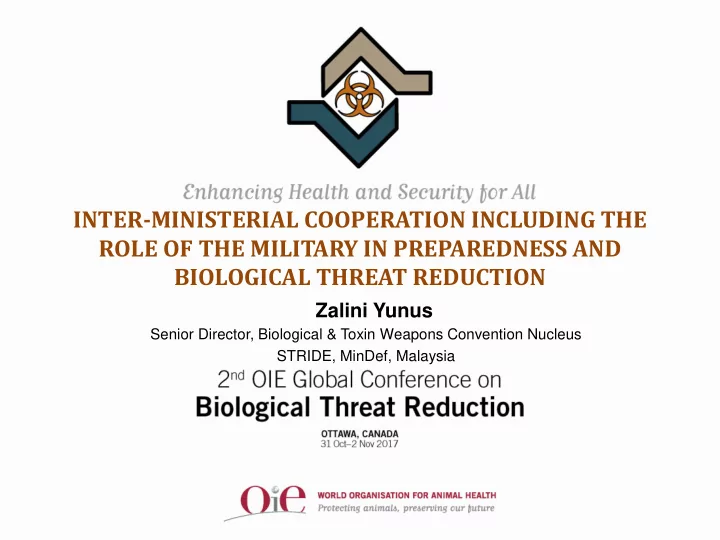

INTER-MINISTERIAL COOPERATION INCLUDING THE ROLE OF THE MILITARY IN PREPAREDNESS AND BIOLOGICAL THREAT REDUCTION Zalini Yunus Senior Director, Biological & Toxin Weapons Convention Nucleus STRIDE, MinDef, Malaysia
NATIONAL SECURITY COUNCIL DIRECTIVES
NSC Directive No. 18 ORGANIZATIONAL STRUCTURE : INTER-AGENCIES COORDINATION Secretariat: NSC Executive Group Secretariat: NSC Secretariat: RMP Crisis Management Homeland Security & Public Order Team National Special Emergency Support Consultative Group Operational Forces Group (NSOF) Malaysian Royal Malaysia Malaysian Red Telekom Emergency Armed Forces Police (RMP) Crescent Society Malaysia Medical Services (MAF) (MRC) Berhad (TMB) Malaysia Fire and Other relevant Rescue agencies Department
ROLES OF NADMA COORDINATION • Govt. Agencies • Private Sectors • NGOs Revised: • Comprehensive response; • More complex disasters; and • More agencies & NGO’s involved
To provide transportation facilities such as RMAF aircrafts, RMN ships and land transportation. To provide expert services such as explosive experts, liaison and field hospital. To provide logistical facilities to aid in crisis management on site To provide air ambulance for emergency assistance. ROLES AND RESPONSIBILITIES (NSC DIRECTIVES) To deploy Special Operational Forces. To provide assistance in terms of leadership to the Crisis Management Team when it is required. To provide communication equipment and technical assistance on site.
BIOLOGICAL INCIDENTS IN THE COUNTRY • Biological incidents in the country mainly natural occurrence : Public health / animal health issues • Nipah / H5N1 / Rabies Outbreaks : better collaboration between public health and animal health • SARS : better coordination between country to country • Natural occurrence – normally law enforcement or first responder are not involved.
WHY MULTISECTORAL COORDINATION IS IMPORTANT? Natural or deliberate: Currently the roles and - Prevention, protection, responsibilities are mainly mitigation, respond and sector-based recovery will be the same. Need programmes to raise the It is important to coordinate and level of understanding and close harmonise. any gaps.
STRIDE – CBEP PARTNERSHIP Among the objectives: To understand multi- sectoral perspectives on biosecurity and To enhance multi- biothreats sectoral policies, goals, To highlight the objectives, roles and importance of responsibilities in biosecurity measures prevention, and biothreats preparedness & reduction response to biological incidents / threats
MULTISECTORAL COORDINATION PROGRAMMES ON BIOSECURITY AND BIOTHREATS REDUCTION November 2012 - Workshop on the Development and the Implementation of Biosecurity and Biorisk Management Programme
February 2013: Workshop on the Development of Biorisk Assessment Toolkits
August 2013: Workshop on Collaborating Across Sectors to Prepare for and Respond to Biological Incidents :.
CHALLENGES • Different level of understanding on biological threats and diseases. • Still have gaps between sectors in the ability to prepare for and respond to biological threats
June 2014: Bioterrorism: Introductory Science to Law Enforcement Training Program June 2014: Blazing Tiger 2014: Bioincident Multisectoral Coordination Exercise
October 2014: Southeast Asia Discussion on Biothreats Biosecurity: Multisectoral Regional Coordination
August 2015: National Interagency Joint Bioincident Investigations Workshop
Dec 2015: SEA DRAGONS II “ASEAN Discussion on Preparedness against Chemical & Biological Threats: : Assessment of Scientific, Prevention and Response Capabilities.
Sept 2016: Bioincident Response Evaluation Workshop (BREW)
March 2017: Workshop on “Biological response investigation training and evaluation ” (BRITE I)
August 2017: Workshop on “Biological response investigation training and evaluation ” (BRITE II)
CONCLUSIONS a) Acknowledged the need for better understanding and coordination of the roles and responsibilities of the respective agencies; b) Brought about thought provoking ideas amongst senior officials to address the strengths, weaknesses, opportunities and threats within the various sectors in handling biological threats; c) Vital to have an inter-agency mechanism for early recognition of unusual events and subsequent response. A good standard operating procedure that applies for all agencies is important. d) Share best practices scenario on how to counter bioterrorism and agroterrorism incidents. e) The bio/agroterrorism and the biological threats could only be managed and overcome through a concerted effort and cooperation among agencies.
ACKNOWLEGMENT MINISTRY OF DEFENCE CBEP DTRA, US DOS MINISTRY OF HEALTH US FBI ROYAL MALAYSIA POLICE GEORGETOWN University MALAYSIAN ARMED FORCES US CDC DEPARTMENT OF VETERINAR SNL SERVICES NATIONAL SECURITY COUNCIL NATIONAL DISASTER MANAGEMENT AGENCY All national and international speakers, SMEs and Facilitators
Thank you ZALINI YUNUS Senior Director, Biological & Toxin Weapons Convention Nucleus STRIDE, MinDef, Malaysia zalini.yunus@stride.gov.my
Recommend
More recommend